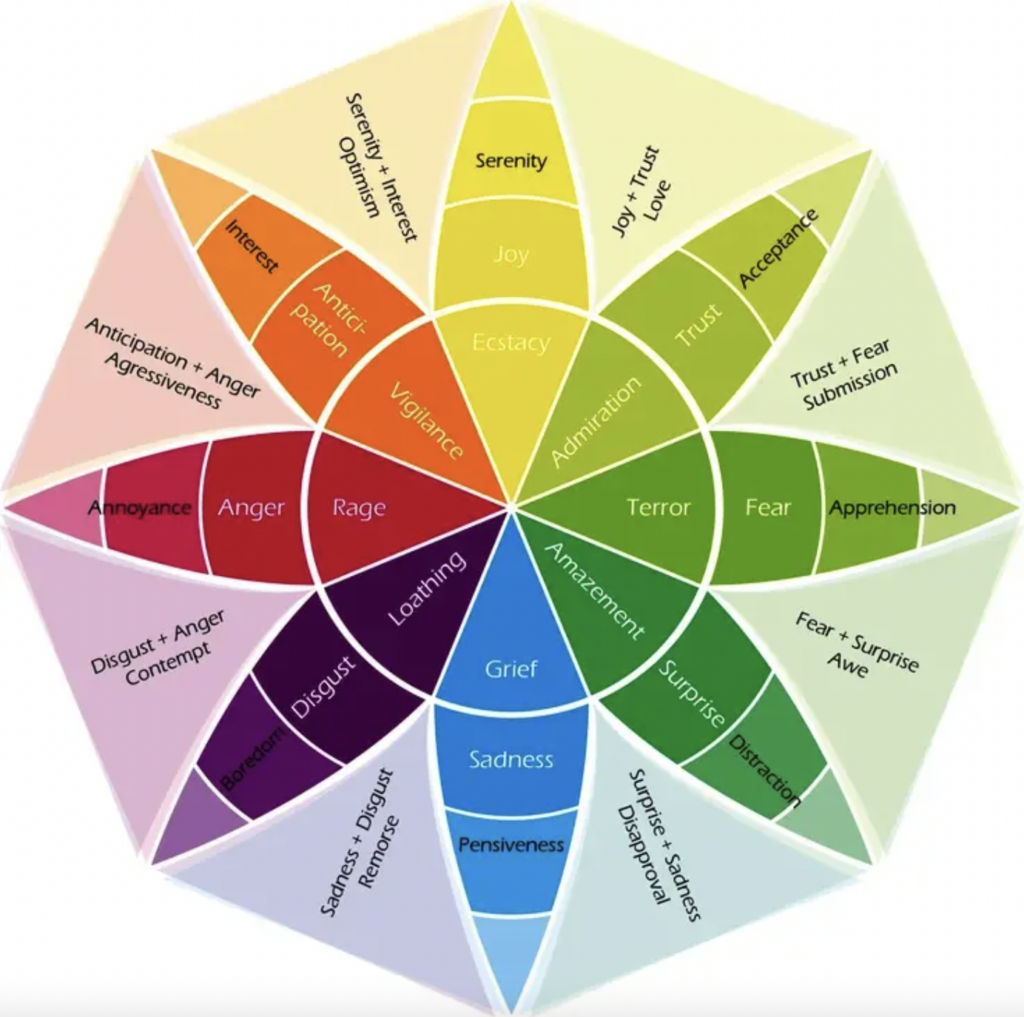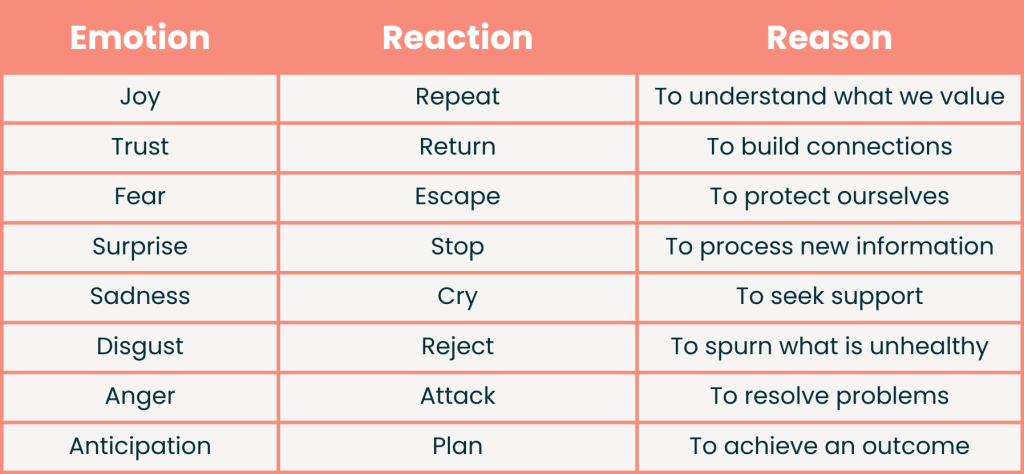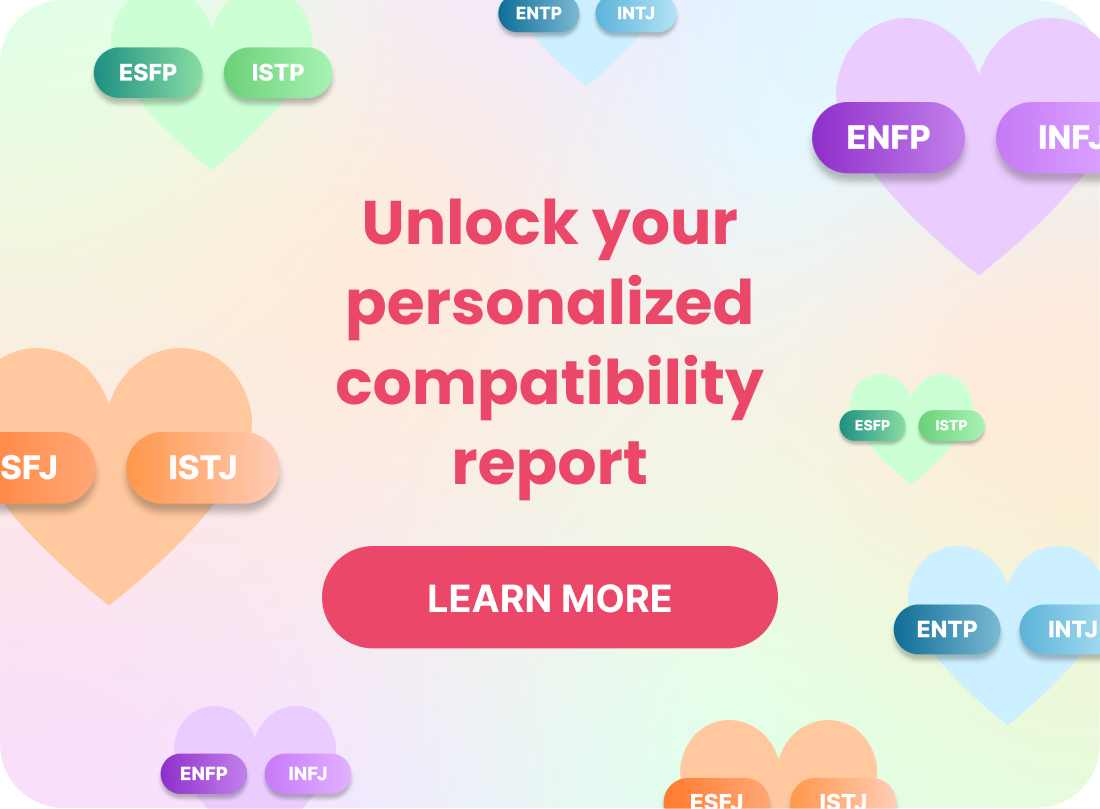The Ultimate Guide to the Emotion Wheel
So first, what is the emotion wheel? The emotion wheel is a tool used to help people identify, understand, and categorize their emotions. It is based on eight primary emotions—anger, anticipation, joy, trust, fear, surprise, sadness, and disgust. The wheel also provides related sub-emotions to help people gain clarity around how they are feeling in greater detail.

So first, what is the emotion wheel? The emotion wheel is a tool used to help people identify, understand, and categorize their emotions. It is based on eight primary emotions—anger, anticipation, joy, trust, fear, surprise, sadness, and disgust. The wheel also provides related sub-emotions to help people gain clarity around how they are feeling in greater detail.
The emotion wheel was created by psychologist Robert Plutchik in 1980. Since then, it has been used in various settings, such as therapy and educational programs. It is a simple but powerful tool that can be used to help people become more aware of their emotions, allowing them to take better control of how they respond to different situations.
The intensity of emotions in the wheel increase as you move inwards towards the center of the wheel, and the emotions on the outside of the wheel have the potential to escalate into those in the inner circles. For example, annoyance has the potential to turn into anger and then rage.

What are emotions?
Emotions are states of feeling which can be experienced both consciously or unconsciously. It is an experience that can be both conscious and unconscious, with its intensity varying from situation to situation. Emotions are also heavily intertwined with our thoughts, memories, and beliefs, making them deeply complex and unique to each individual.
Emotions are integral to our daily lives because they enable us to assess situations, make decisions, and regulate our behavior. They also allow us to ensure that our actions are in alignment with our values. Fundamentally, our emotions are designed to protect us. You can think of our emotions as guides that are trying to keep us from harm, both mentally and physically.
For example, if someone tries to physically hurt you and you feel fearful, that emotion is protecting you by alerting you to a potential threat. Another example of emotions protecting you from harm is if you cheated on a test and felt guilty. The emotion of guilt is telling you that your actions weren’t in line with your values. Last but not least, when someone crosses one of your boundaries and you feel angry, your emotion is protecting you by letting you know that this isn’t acceptable behavior and that you need to take action.
But more often than not, we need to be able to recognize and manage our emotions in order for them to be beneficial.
What are the benefits of the emotion wheel?
The emotion wheel is a great tool to help you identify, understand, and manage your emotions. Emotions are highly complex, and, like with any sophisticated system, it helps to have a framework to categorize information and break it down into more manageable components.
The emotion wheel can also help you become aware of emotional patterns, track your emotional changes over time, and recognize emotional triggers. All of this information can be used to create emotion management strategies that will enable you to better cope with difficult situations and even prevent them from occurring, if necessary.
The emotion wheel can also be used to help you understand other people’s feelings and reactions better. This allows us to respond to people in a more understanding and compassionate way.
Understanding both our own and other people’s emotions can help us build healthier, deeper relationships and create a more fulfilling life. There are many more benefits, too.
The sections in between the spokes of the emotion wheel are emotions that result from a combination of two primary emotions. For example, joy and trust combine to make love, while surprise and sadness combine to make disapproval.
Ultimately, using the emotion wheel can help us to become the best versions of ourselves and bring more joy to the world.
How should you use the emotion wheel?
Let’s take a look at how to use the emotion wheel. First, take a step back and observe your emotion. Take a moment to accept how you feel without judgment. Then, look at the emotion wheel and use it to categorize your emotion. Having a diagram like this can help to make it easier for you to identify and define it.
Once you’ve identified the emotion, take a deeper look at it. Examine the emotion more closely and ask yourself questions such as “What is the emotion’s intensity? Is it fleeting or sustained? How long have I been feeling it?” This enables you to understand the emotion in greater detail.
The next step is to consider the cause of the emotion. What was happening when you first noticed the emotion? Is it something that’s happened before or a new experience? Look for patterns and see if a particular emotion is connected to certain events or situations. Understanding the emotion trigger can help you to manage the emotion more effectively and be better prepared for similar situations in the future.
Lastly, once you’ve identified the emotion, it’s important to consider if you want to take action or not. Do you think you could be responding in a different way? Is there something you can do to manage the emotion, or is it best for you to just let it be? For example, if you’re feeling sad, is there something you can do to make yourself feel better, or do you just need to sit with the emotion and let it pass?
What about repressing emotions?
It’s important not to repress emotions because it backfire in the long run. Research has shown that there is a clear link between repressing emotions and health issues, both mental and physical. The effects include anxiety, depression, and other stress-related illnesses.
However, navigating and regulating your emotions is a completely different approach to suppressing them. The emotion wheel can help you to identify, understand, and take action on your emotion in a constructive way. Essentially, mindfully managing your emotions can be helpful for working through difficult emotions and developing coping skills.
It’s worth noting that emotion management strategies vary between people, so it’s important to find the best one for you. Remember, emotions are there to protect and serve you, and when managed correctly, they can be incredibly powerful and beneficial to you.
How do our emotions affect our lives?
It is undeniable that emotion plays an important role in our daily lives. Emotions help us to recognize and respond to different situations, guide us toward achieving our goals, and help us build relationships with others.
Our emotions also have an effect on both our mental and physical health. For example, when we experience negative emotions such as fear and anger, our body releases hormones that cause physical changes in the body, such as increased heart rate and blood pressure. On the other hand, when we experience positive emotions such as joy and contentment, our body releases endorphins, which can reduce stress and make us feel relaxed.
Ultimately, emotions have a huge impact on our lives, and it’s important to be aware of this. We briefly touched on examples of how emotions guide us through life in the introduction, but here is a more comprehensive table of each primary emotion, the reaction it triggers, and the action it guides us toward.
You can see from the table that each and every emotion is a powerful tool that helps us to navigate the world. You can see how each emotion has a clear purpose and understanding this is key to emotion management.

Learning how to identify and work with our emotions can be incredibly beneficial for both our mental and physical health. And the emotion wheel can be a great tool for this journey.
Exploring the 8 primary emotions
We are now going to explore each of the primary emotions from the emotion wheel to understand how they benefit us when managed correctly.
1. Joy.
Joy is a positive emotion that we feel when something we perceive to be good happens. It helps us realize what we value and what we want more of in our lives. When we experience joy, we are drawn to repeating whatever it is that made us feel like that.
Example: If you try a new dish at a restaurant and you really like it, joy encourages you to try the dish again.
2. Trust.
Trust is an emotion that we feel when we perceive something or someone as safe or secure. It enables us to rely on others, build relationships, and seek that which keeps us safe. When we experience trust, it encourages us to return to that person or situation.
Example: If you have a close friend whom you’ve known for years, trust encourages you to lean on them for help in times of need rather than seeking advice from strangers.
3. Fear.
Fear is an emotion that we feel when we are presented with something or someone we perceive to be dangerous. It helps us avoid danger by protecting ourselves. When we experience fear, we feel a need to escape the situation.
Example: If someone approaches you late at night in a dark alley, fear encourages you to get out of the situation as quickly as possible.
4. Surprise.
Surprise is an emotion that we feel when something we perceive as unexpected happens. It helps us to be aware of change and process new information. When we experience surprise, we often pause and take a moment to reorient ourselves.
Example: If a colleague turns up at the office with a dramatic new hairstyle, the surprise encourages you to take a moment and process the unexpected change before continuing with your day.
5. Sadness.
Sadness is an emotion that we feel when something we perceive to be bad happens. It helps us to seek comfort from others. When we experience sadness, it encourages us to cry, which lets other people know that we need support.
Example: If you break up with your partner, sadness encourages you to reach out to a friend so they can help you deal with the situation.
6. Disgust.
Disgust is an emotion that we feel when we perceive something to be wrong. It helps us to reject that which we don’t want in our life. When we experience disgust, it encourages us to reject the person or object.
Example: If you try a new food that tastes terrible, disgust encourages you to reject the food and not eat it again.
7. Anger.
Anger is an emotion that we feel when something we perceive something to be unfair. It helps us to protect ourselves and fight for justice. When we experience anger, it encourages us to take action and confront the person or situation, either verbally or physically.
Example: If you see an animal being treated badly, anger encourages you to confront the perpetrator and rectify the situation.
8. Anticipation.
Anticipation is an emotion that we feel when something we perceive to be important is about to happen. It helps us look forward to future events and plan accordingly. When we experience anticipation, it encourages us to prepare for the upcoming event, which makes us more likely to achieve a desired outcome that will be beneficial for us.
Example: If you are about to go on a job interview, anticipation encourages you to prepare for the interview by researching the company, brushing up on your skills, and practicing your responses.
So, we’ve now looked at how each emotion motivates us to respond. But whether you take action is another story. Of course, just because you feel like doing something, it doesn’t always mean it’s justified or that it’s something you should do. This is where self-reflection and understanding healthy vs unhealthy patterns and responses come in.
Final thoughts on the emotion wheel
The emotion wheel is a great tool for understanding yourself on a deeper level. In addition, self-awareness is essential if you want to live the most fulfilling life, show up in the best possible way for those close to you, and take action in a constructive way.
Understanding our emotions also encourages us to be grateful for each and every emotion we experience. It can be easy to wish that we could just feel positive emotions all the time. But then we would end up putting ourselves in danger because we wouldn’t have any warning signs. Even the most uncomfortable emotion has something to teach us and allows us to grow and develop.
By taking the time to learn about emotion, identify emotion triggers, and create emotion management strategies, you’ll be better equipped to navigate the ups and downs of life. And the emotion wheel is a great way to start that journey. After all, understanding is the first step to positive change.
If you enjoyed this blog, you might also enjoy 50 powerful self-love quotes to inspire you.




